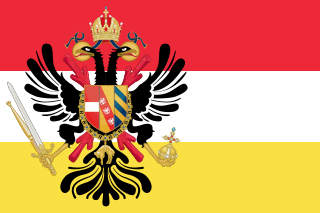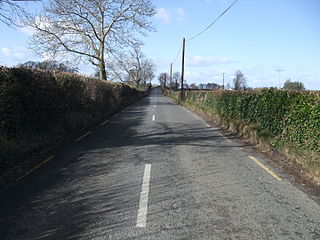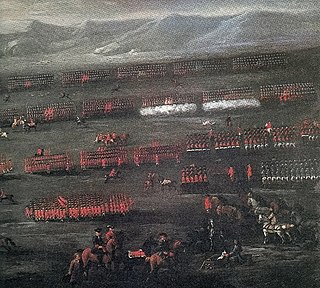
Sophia was Electress of Hanover from 19 December 1692 until 23 January 1698 as the consort of Elector Ernest Augustus. She was later the heiress presumptive to the thrones of England and Scotland and Ireland under the Act of Settlement 1701, as a granddaughter of James VI and I. Sophia died less than two months before she would have become Queen of Great Britain and Ireland. Consequently, her son George I succeeded her first cousin once removed, Queen Anne, to the British throne, and the succession to the throne has since been defined as, and composed entirely of, her legitimate and Protestant descendants.
The Whigs were a political faction and then a political party in the Parliaments of England, Scotland, Ireland, Great Britain and the United Kingdom. Between the 1680s and the 1850s, the Whigs contested power with their rivals, the Tories. The Whigs merged into the Liberal Party with the Peelites and Radicals in the 1850s. Many Whigs left the Liberal Party in 1886 to form the Liberal Unionist Party, which merged into the Conservative Party in 1912.

George II was King of Great Britain and Ireland, Duke of Brunswick-Lüneburg (Hanover) and a prince-elector of the Holy Roman Empire from 11 June 1727 (O.S.) until his death in 1760.

George I was King of Great Britain and Ireland from 1 August 1714 and ruler of the Electorate of Hanover within the Holy Roman Empire from 23 January 1698 until his death in 1727. He was the first British monarch of the House of Hanover as the most senior Protestant descendant of his great-grandfather James VI and I.

The Riot Act, sometimes called the Riot Act 1714 or the Riot Act 1715, was an act of the Parliament of Great Britain which authorised local authorities to declare any group of 12 or more people to be unlawfully assembled and order them to disperse or face punitive action. The act's full title was "An Act for preventing tumults and riotous assemblies, and for the more speedy and effectual punishing the rioters", and it came into force on 1 August 1715. It was repealed in England and Wales by section 10(2) and Part III of Schedule 3 of the Criminal Law Act 1967. Acts similar to the Riot Act passed into the laws of British colonies in Australia and North America, some of which remain in force today.

The Kingdom of Great Britain, officially Great Britain, was a sovereign country in Western Europe from 1 May 1707 to the end of 31 December 1800. The state was created by the 1706 Treaty of Union and ratified by the Acts of Union 1707, which united the kingdoms of England and Scotland to form a single kingdom encompassing the whole island of Great Britain and its outlying islands, with the exception of the Isle of Man and the Channel Islands. The unitary state was governed by a single parliament at the Palace of Westminster, but distinct legal systems—English law and Scots law—remained in use.

The House of Hanover, whose members are known as Hanoverians, is a European royal house of German origin that ruled Hanover, Great Britain, and Ireland at various times during the 17th to 20th centuries. The house originated in 1635 as a cadet branch of the House of Brunswick-Lüneburg, growing in prestige until Hanover became an Electorate in 1692. George I became the first Hanoverian monarch of Great Britain and Ireland in 1714. At Queen Victoria's death in 1901, the throne of the United Kingdom passed to her eldest son Edward VII, a member of the House of Saxe-Coburg and Gotha. The last reigning members of the House of Hanover lost the Duchy of Brunswick in 1918 when Germany became a republic.

The Georgian era was a period in British history from 1714 to c. 1830–1837, named after the Hanoverian kings George I, George II, George III and George IV. The definition of the Georgian era is often extended to include the relatively short reign of William IV, which ended with his death in 1837. The subperiod that is the Regency era is defined by the regency of George IV as Prince of Wales during the illness of his father George III. The transition to the Victorian era was characterized in religion, social values, and the arts by a shift in tone away from rationalism and toward romanticism and mysticism.
This is the family tree of the British royal family, from James I to the present monarch, Charles III.

The Austrian Netherlands was the territory of the Burgundian Circle of the Holy Roman Empire between 1714 and 1797. The period began with the Austrian acquisition of the former Spanish Netherlands under the Treaty of Rastatt in 1714 and lasted until Revolutionary France annexed the territory during the aftermath of the Battle of Sprimont in 1794 and the Peace of Basel in 1795. Austria, however, did not relinquish its claim over the province until 1797 in the Treaty of Campo Formio.
Circuit courts are court systems in several common law jurisdictions. The core concept of circuit courts requires judges to travel to different locales to ensure wide visibility and understanding of cases in a region. More generally, the term may also refer to a court that merely holds trials and other proceedings at a series of multiple locations in some kind of rotation.

The Longitude Act 1714 was an Act of Parliament of Great Britain passed in July 1714 at the end of the reign of Queen Anne. It established the Board of Longitude and offered monetary rewards for anyone who could find a simple and practical method for the precise determination of a ship's longitude. The Act of 1714 was followed by a series of other Longitude Acts that revised or replaced the original.
Events from the year 1720 in Ireland.

The R666 road is a regional road in Ireland which runs west-east from the R639 in Fermoy town centre to the bridge over the River Blackwater on the outskirts of Lismore. The road passes through Ballyduff, and beneath the River Blackwater viaduct which carries the M8 motorway. The R666 begins in Fermoy as the Rathhealy Road. From here to its merger with the R667 road 3km south of Kilworth, the R666 was once part of the historic road linking Dublin and Cork. It was mapped as such by Herman Moll in his 1714 New Map of Ireland.

The Succession to the Crown Act 1707 is an Act of Parliament of the Parliament of Great Britain. It is still partly in force in Great Britain.

The R670 road is a regional road in Ireland. The route runs from its junction with the R639 and N24 at Cloughabreeda 2 km north of Cahir through Cahir town and onwards for a further 8 km to Ardfinnan, where it joins the R665 road. The R670 is located entirely in County Tipperary.

The R667 road is a regional road in Ireland. The route runs from its junction with the N8 1 km from Kilworth for approximately 5 km until it meets the R666 road northeast of Fermoy. The R667 was once part of the main road from Dublin to Cork, and was mapped as such by Herman Moll in his New Map of Ireland in 1714. The road is located entirely in County Cork.
Events from the year 1692 in Ireland.

The Jacobite rising of 1715 was the attempt by James Edward Stuart to regain the thrones of England, Ireland and Scotland for the exiled Stuarts.













